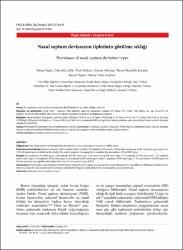Nazal septum deviasyon tiplerinin görülme sıklığı

Göster/
Erişim
info:eu-repo/semantics/openAccessTarih
2017-03Yazar
Yeğin, YakupÇelik, Mustafa
Erdem, İrem
Altıntaş, Ahmet
Şimşek, Baver Maşallah
Olgun, Burak
Kayhan, Fatma Tülin
Üst veri
Tüm öğe kaydını gösterKünye
Yeğin Y, Çelik M, Erdem İ, Altıntaş A, Şimşek BM, Olgun B, Kayhan FT [Nazal septum deviasyon tiplerinin görülme sıklığı] FNG & Bilim Tıp Dergisi 2017; 3 (1) : 4-8 doi:10.5606/fng.btd.2017.002Özet
ÖZ
Amaç: Bu çalışmada nazal septum deviyasyon (NSD) tiplerinin görülme sıklığı araştırıldı.
Hastalar ve yöntemler: Ocak 2012 - Haziran 2016 tarihleri arasında çalışmaya toplam 497 hasta (317 erkek, 180 kadın; ort. yaş 32.4±11.9 yıl,
dağılım 18-60 yıl) dahil edildi. NSD tiplerinin sıklığı bilgisayarlı tomografi kullanılarak araştırıldı.
Bulgular: Nazal septum deviyasyon tiplerine göre 226 hasta (%45.5) tip 3, 81 hasta (%16.3) tip 2, 77 hasta (%15.5) tip 1, 41 hasta (%8.2) tip 4, 35 hasta
(%7.0) tip 5, 20 hasta (%4.0) tip 6 ve 17 hasta (%3.4) tip 7 idi. Kadın hastalarda NSD tip 3 görülme sıklığı erkeklere göre istatistiksel olarak anlamlı düzeyde
yüksek idi (p=0.023).
Sonuç: NSD tiplerinin ameliyat öncesi belirlenmesi, cerrahi planlamada cerraha yol gösterici olacaktır. Farklı NSD tip sınıflandırmaları olsa da, ameliyat
öncesi cerrahi yöntemlerin belirlenmesine yardımcı olacak daha uygun sınıflandırmalara ihtiyaç duyulmaktadır.
Anahtar sözcükler: Septoplasti; septum deviyasyonu; tip 3. ABSTRACT
Objectives: This study aims to investigate the prevalence of the nasal septum deviation (NSD) types.
Patients and methods: Between January 2012 and June 2016, a total of 497 patients (317 males, 180 females; mean age 32.4±11.9 years; age range from
18 to 60 years) were included in the study. We used computed tomography to examine the prevalence of the NSD types.
Results: According to the NSD types, 226 patients (45.5%) were type 3, 81 patients (16.3%) were type 2, 77 patients (15.5%) were type 1, 41 patients
(8.2%) were type 4, 35 patients (7.0%) were type 5, 20 patients (4.0%) were type 6 and 17 patients (3.4%) were type 7. The prevalence of NSD type 3 in
female patients was significantly higher than that of male patients (p=0.023).
Conclusion: Preoperative determination of NSD types will guide the surgeon in surgical planning. Although there are different NSD type classifications,
there is a need for new classifications of more relevant NSD types to help determine preoperative surgical methods.
Keywords: Septoplasty; septum deviation; type 3.

















